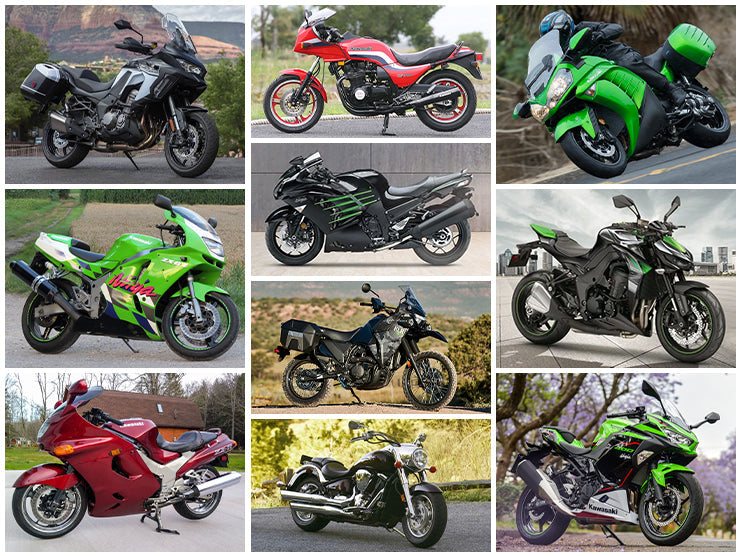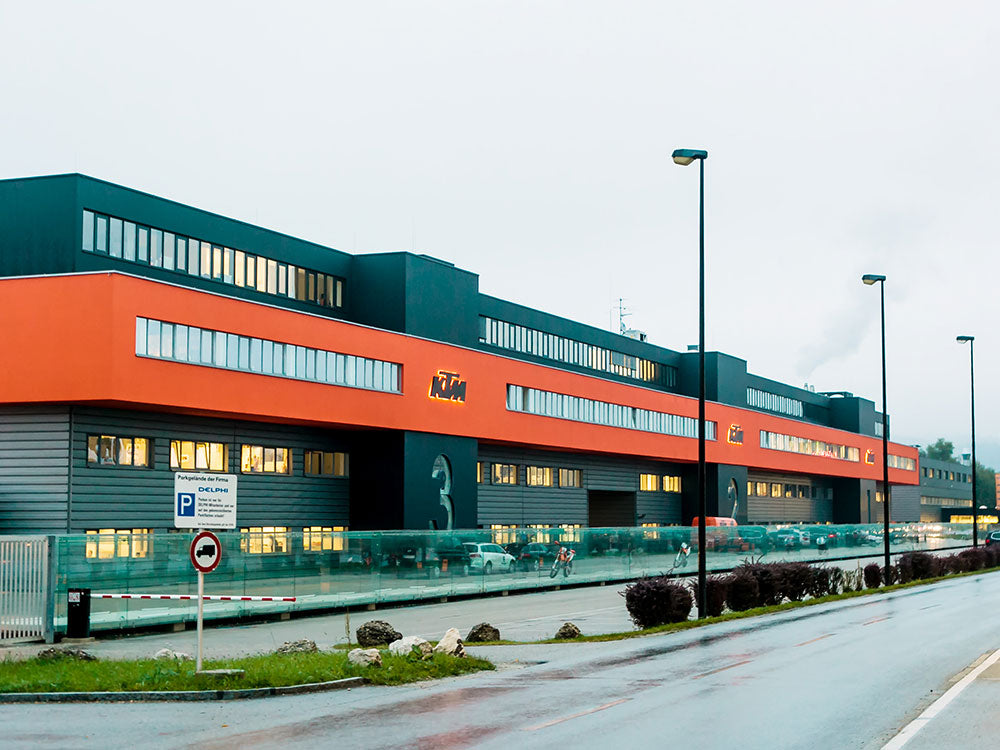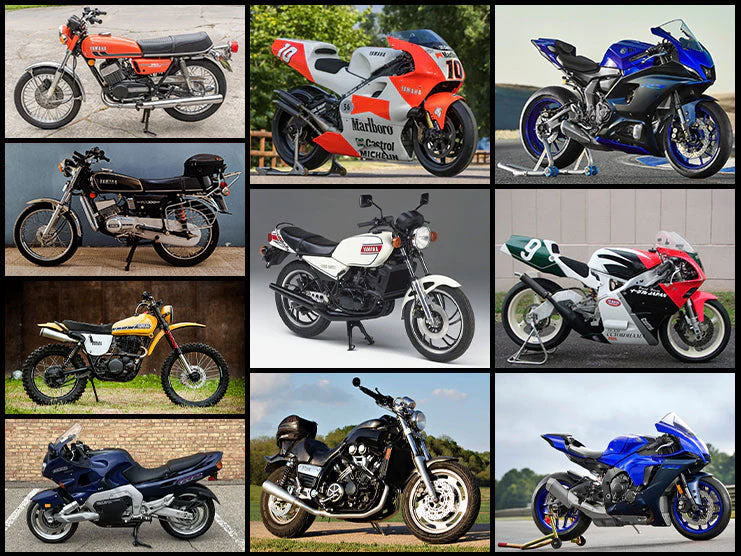Kawasaki is one of the last Japanese companies to enter the motorcycle industry. Before undertaking this venture, Kawasaki had already proved its engineering and technological expertise by building ships that sailed all around the world, bullet trains that could travel 175 miles per hour, and parts for cars and jet aircrafts, and industrial equipment. Kawasaki has developed powerful engines for different vehicles and it was only a matter of time before the company got into the motorcycle business. However, making powerful but small engines that could fit a motorcycle was quite a challenge for the Kawasaki engineers. But Kawasaki’s team of engineers took the world by surprise with revolutionary engines and design concepts ever produced. Bold paint jobs were another trend introduced by Kawasaki as the sharp unusual colors attracted more attention. The trademark color of Kawasaki was reinforced by the Ninja series. Through Ninja alone, Kawasaki achieved much success and challenged the giants of the motorcycle industry. However, several other motorcycles contributed to the motorcycle brand’s success. This article has compiled a list of the ten best motorcycles Kawasaki ever made.
Table of Content
1. The Story of Kawasaki Motorcycles
Kawasaki was founded by Shozo Kawasaki in 1878. The Kawasaki Heavy Industry began as a ship-building company and soon became the world’s manufacturing giant. However, not many knew Kawasaki’s name. To increase brand awareness and acquire recognition, Kawasaki entered the motorcycle business and made its first two-wheeler in 1955. To build its first motorcycle, Kawasaki assigned engineers from its aircraft division. The team of engineers created a variety of motorcycles from 1955-1965 but none of these motorcycles were special as they failed to address Kawasaki’s mission of developing new technologies for a breakthrough motorcycle engine design.
1.1 Kawasaki H1 Mach 3 (1969-1975)
In 1968, the Kawasaki H1 Mach 3 was developed. The engineers intended it to be an experimental project, but it became the motorcycle that reflected Kawasaki’s mission. For this engineering task, two teams of engineers were pitted against each other. One team created a two-cylinder engine, while the other team created a revolutionary 500 cc three-cylinder engine. Until the Kawasaki Mach 3, no Japanese motorcycle company had ever designed a motorcycle with a three-cylinder engine. Though the three-cylinder engine could generate massive amounts of horsepower, its middle cylinder tended to overheat quickly due to which engine failed. Engineers fixed this issue by installing extra large cooling fins to the engine. Hence, the Mach 3 went from an experimental project to a production motorcycle. Resultantly, the Kawasaki Mach 3 was introduced in the United States in 1969. Featuring an air-cooled two-stroke two cycle engine with three cylinders, the Kawasaki Mach 3 marked Kawasaki’s entry into the motorcycle market. The Mach 3 was a success because of its impressive acceleration and 60 hp of horsepower. When it went on sale it was the fastest production motorcycle of its time. Kawasaki discontinued the production of Mach 3 in 1975.
1.2 Kawasaki Z1 (1972-1976)
Though Kawasaki became famous due to the Mach 3, to take on Honda, Suzuki, and Yamaha, it required a long-term strategy. For Kawasaki, this strategy meant continuing the revolution that was started by the Mach 3. After three years of producing the Mach 3, Kawasaki introduced another breakthrough motorcycle design in the United States in 1972, the Kawasaki Z1. The Z1, also called the 900 Super Four, featured a four cylinder 900 cc engine. The Z1 produces 100 hp of horsepower and established the Kawasaki brand as the performance force. This beautiful motorcycle was unique not just because of its large displacement, but also because of its four exhaust pipes and disc brakes. With its large engine, fast acceleration, and muscular sporty aesthetic, the Z1 popularized the superbike concept among the masses. On the streets, the Z1 was the sportiest bike of that time, but the bike proved its sportiness by becoming the first motorcycle to win the American Motorcycle Association Championship. Kawasaki managed to bag the title for two consecutive years, 1977 and 1978.
Winning the championship twice helped Kawasaki increase its sales, especially in the United States. The bike riders bought off the showroom floor could run 125 miles per hour. With an excellent braking system, one could actually reach the claimed speed on open roads.
1.3 1st Generation Kawasaki Ninja - Redefining the Modern SportBike
Kawasaki was one of the last to enter the motorcycle production business but was catching up fast. By the late 1970s, the brand had created two revolutionary motorcycles and won two racing championships. Since the Kawasaki Z1 set new standards for the sport bike segment, Kawasaki decided to redefine the concept of modern sport bike. In September 1980, Kawasaki’s Japan wing announced a new bike, the Kawasaki Z900 R. But Kawasaki’s American wing named the bike Tanuja. In addition, the Kawasaki Motors Corporation in the United States also coined the Ninja name that stuck. After choosing a unique name, Kawasaki picked a unique color, lime green for the Ninja racetrack version. The color green was thought to be bad luck on the race tracks in the 1960s. Kawasaki wanted to demonstrate its faith in its engineering by painting the bike “ a color of defiance.”
The first generation Ninja 900 production motorcycle was the first Kawasaki with a liquid-cooled compact engine, computerized ignition system, advanced suspension system, a unique red paint job, small handlebars, correct ride height, and a new seat design. The Ninja 900 also generated an impressive 115 hp of horsepower. In the Ninja 900, the engine was installed in the downward and forward direction to keep the center of gravity low. The fairing design enhanced the top speed and offered optimal protection. The top speed of the bike was about 150 mph. Kawasaki Ninja motorcycles became synonymous with sports bikes and their impact is continued even today.
2. The Best of Kawasaki Motorcycle Craftsmanship
After Ninja, Kawasaki introduced many revolutionary motorcycles with new designs. Another breakthrough model was launched in 1990 that propelled Kawasaki’s success to new heights. These motorcycles pushed the motorcycle engine development further and are expected to reach the vintage status in the near future.
2.1 Kawasaki Ninja ZX-11

The Kawasaki Ninja ZX-11 or the Kawasaki ZX-1100 was the first touring motorcycle introduced by the brand in 1990. The Kawasaki Ninja ZX-11 was discontinued after 2001. The motorcycle was designed based on the American hot rod engine. To increase the horsepower, the engineers increased the airflow to the engine. The Kawasaki Ninja ZX-11 was the first motorcycle with a 1052 cc ram-air engine in the world. The ram-air engines apply a simple concept, the faster you ride your motorcycle, the more air flows into the engine making it more powerful. The Ninja ZX-11 could produce 160 hp of horsepower and the top speed of 183 miles per hour.
2.2 Kawasaki Ninja ZX-14

In 2006, the Kawasaki engineers decided to create the fastest street-legal motorcycle by creating a large sized motorcycle called the Ninja ZX-14. This motorcycle was powered by a 1.4 liter/0.36 gallon four stroke, liquid cooled inline-four 1441 cc engine. The ZX-14 engine was big enough to be installed in a car. Consequently, the Ninja ZX-14 motorcycle became faster than any car on the road during its production years. The design team also had to come up with a new stronger frame that could handle the engine power. With a top speed of 186 mph and horsepower of 208 hp. Over the years, the bike received different technological upgrades, such as the anti-lock braking system, traction control, riding modes, and electronic fuel injection system. Due to its touring abilities and customization potential, the Ninja ZX-14 became what the engineers wanted it to become, “The King of Open Roads.” The Ninja ZX-14 R ABS version is still under production and the 2024 model is also expected.
2.3 Kawasaki Ninja ZX-6R

The Kawasaki Ninja- ZX-6R is a middleweight sport bike and was created to reach out to potential buyers who were not able to ride the Ninja ZX-14 due to its exceptional speed and power. Featuring a smaller 636 cc liquid cooled inline four engine that generates about 11 5hp of horsepower, the ZX-6R inspires the confidence in riders and helps them prepare for the biggest most powerful Kawasaki motorcycle, the Ninja ZX-14. The ZX-6R was introduced in 1995 and has received multiple technological upgrades since its launch. Depending on the model you buy, the bike will be equipped with advanced braking setup, improved shifter systems, and ride modes. The ZX-6R has a comfortable upright seating position for race track riding, commuting, and highway rides. The Ninja ZX-6R is Kawasaki’s most nimble motorcycle to date.
2.4 Kawasaki Vulcan 2000

Kawasaki is well known for its sports bikes and reviving the super sport genre. However, the company produced motorcycles that appealed to a range of riders and not just speed junkies. In the mid 1980s, Kawasaki introduced its first cruiser model, the Kawasaki Vulcan 750. But the breakthrough model was the Vulcan 2000 introduced in 2004. The Vulcan 2000 is the largest motorcycle ever built featuring a V4 2053 cc engine, five speed transmission, and a belt drive. The bike weighs about 814 lbs and has a fuel capacity of 5.5 gallons. Due to its appearance, the bike was called Kawasaki’s muscle bike. This highway cruiser is designed for comfortable long rides. The Vulcan 2000 can generate 116 hp and has a top speed of 150 miles per hour.
2.5 Kawasaki KLR 650

In 1987, Kawasaki created the KLR 650, a dual sport motorcycle. The letters KLR in the name stand for “ Kawasaki, Lifestyle, Recreation.” True to its name, the bike introduced the riders to a whole new lifestyle of motocamping, off-road riding, and adventure. The KLR 650 was unique from other Kawasaki motorcycles because it featured a single-cylinder engine. The long travel suspension, comfortable ergonomics, large fuel tank, robust chassis, made this bike a reliable two-wheeler that could handle any terrain. The design and technological features were kept to a minimum for ease of maintenance.
The KLR650 with its straightforward purposeful design was a huge hit but the brand dropped the bike’s production in 2018 due to emission regulations.
2.6 Kawasaki Concours 14

Kawasaki Concours 14 or ZG1400 is the grand touring motorcycle to cater to riders who prefer luxury touring bikes. This sport touring motorcycle was introduced in 2007 and features a 1352 cc inline engine. With a top speed of 155 mph and 155 brake horsepower, the Concours 14 made its own place in the highly competitive motorcycle segment. The bike is equipped with a full fairing, luggage bags, adjustable windshield and some technological features, including traction control, ABS, and a built-in tire pressure monitor. Kawasaki did not launch the 2023 model of Concours 14 and there is no announcement for a 2024 model as yet.
2.7 Kawasaki Versys 1000

The adventure motorcycle has its roots in the 1930s, but the first adventure motorcycle, but the official adventure touring motorcycle segment was introduced in the1980s. Though Kawasaki launched its dual-sport in 1987, it improvised and launched its best adventure motorcycle to date in 2012. The Kawasaki Versys 1000 had a bigger 1,043 cc inline four engine and could handle long highway stretches, allowing riders to explore remote off-road areas. The bike has a distinct sporty character combined with touring comfort and is considered one of Kawasaki’s best motorcycles of all time.
2.8 Kawasaki Ninja 400

Kawasaki Ninja ZX-14 and the Ninja ZX6R are expert bikes, something a novice rider cannot ride without getting into trouble. This created a market gap that Kawasaki filled much later by introducing the Ninja 400 or Z400 motorcycle. Stylish and sporty, the Ninja 400 was launched in 2018 and featured a 399 cc parallel twin engine. The bikes have a fun factor but produce manageable speed. The anti-lock braking system offers the confidence boost keeping the bike stable on low-traction surfaces. The full fairing equipped Ninja 400 with a 30.9 inch seat height is the best beginner friendly motorcycle Kawasaki ever came up with.
2.9 Kawasaki GPZ1100

The Kawasaki GPZ1000 was the naked sport bike and quite the trend-setter in the 1980s. Launched in 1986, the GPZ1000 grabbed attention for its stripped down look and race bike attributes. The bike later served as the template/foundation of modern streamlined superbikes. The GPZ1000 engine was one of Kawasaki's last air-cooled sportbike engines. This motor had a displacement of 1089 cc and produced about 120 hp of horsepower. With better braking power and improved shock absorbency, the GPZ1000 had all the attributes of a well-designed super bike. Despite its reliable handling, brakes, and suspension, it required a lot of skill due to its top speed of 135 mph.
2.10 Kawasaki Z1000

Kawasaki Z1000, a naked sport bike, was launched in 2003. At that time, motorcycle companies focused more on creating powerful engines and the fastest street bikes. Little attention was given to handling, braking, and suspension. The street-fighter-inspired Kawasaki Z1000 was not only known for its 1015 cc air-cooled engine that could generate 83 hp of horsepower and had 125 mph. The bike was praised for striking the balance between immense power and stability. At the time of its launch, the disc brake setup felt inadequate. Over the years, engineers improved the braking power. But even with its shortcomings, the Z1000 was a success and used as a base model for motorcycles that were launched after it.
3. Last Words
Ever since it entered the motorcycle business, Kawasaki has built some of the most stylish, fastest, and most powerful motorcycles in the world. Choosing any 10 best motorcycles is not an easy task. All the motorcycles above either have a historical importance or are known for their unique genre. In addition, they helped take the motorcycle engine development further. Some of the motorcycles are still under production while others have acquired vintage status. But each Kawasaki motorcycle is a testament of company’s excellent engineering and motorcycle artistry.













1 comment
Kevin Mc
Nice write up but about the ZX14Rs top speed. Of course it’s 186 as all capable bikes in the US are governed at 186, what would it run unrestricted???
Also I can’t help but wonder why the ZX10R and the H2s are not mentioned, such fine machines.
Leave a comment
All comments are moderated before being published.
This site is protected by hCaptcha and the hCaptcha Privacy Policy and Terms of Service apply.